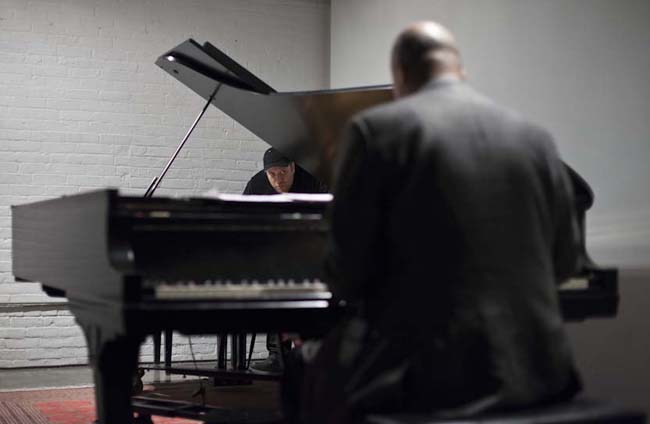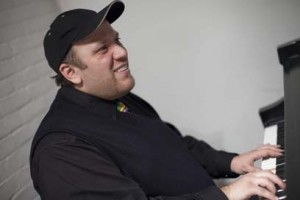 Gallery 345, Toronto. December 18, 2012
Gallery 345, Toronto. December 18, 2012
Picture yourself part of a gathering seated in an elegant ‘L-shaped’ salon with two grand pianos tucked in the angle. You are about to enjoy a keyboard conversation between Hilario Duran and Robi Botos, two of the most adept jazz improvisors in Canada. They’ve never worked together before tonight, so the show is a bit of mystery.
 Hilario takes the introductory melody part, rippling out florid arpeggios in a sophisticated style. Robi works the background with chunky, funky progressions, and the piece evolves into a huge bluesy rhapsody that moves in shifting rhythms like two boxers feeling each other out in the first round.
Hilario takes the introductory melody part, rippling out florid arpeggios in a sophisticated style. Robi works the background with chunky, funky progressions, and the piece evolves into a huge bluesy rhapsody that moves in shifting rhythms like two boxers feeling each other out in the first round.
 In the second round, Robi leads off with one hand bonking the keys, his other is ‘in’ the piano keeping the damper down. Hilario trills and frills and ramps the tune up to a fast boogie that’s starting to sound like “I’ve Got Rhythm,” George Gershwin’s 1928 study in syncopation that hangs behind the beat with one hand and rushes it with the other. Pretty soon Robi and Hilario are adjusted, like an odd married couple who can finish each other’s sentences. When they are done fracking this number, the audience breaks into joyful laughter.
In the second round, Robi leads off with one hand bonking the keys, his other is ‘in’ the piano keeping the damper down. Hilario trills and frills and ramps the tune up to a fast boogie that’s starting to sound like “I’ve Got Rhythm,” George Gershwin’s 1928 study in syncopation that hangs behind the beat with one hand and rushes it with the other. Pretty soon Robi and Hilario are adjusted, like an odd married couple who can finish each other’s sentences. When they are done fracking this number, the audience breaks into joyful laughter.
We are totally in their hands now, and the set develops through a sequence of show-tunes mostly from the ’30’s, that became jazz standards. “Body and Soul” by Johnny Green that grew from show to pop to swing to bebop. Cole Porter’s “What Is This Thing Called Love?” a soppy popsong written for a musical that went on to live in the imaginations of musicians with styles as various as stride pianist James P. Johnson, Sonny Rollins, and Charlie Mingus. “Let’s Face the Music and Dance” a movie tune by Irving Berlin that brings back the energy of Fred Astaire and Ginger Rogers. This is all music that takes you up to higher, happier times and makes you want to sing and dance. The guys end their set on a hip note with Dizzy Gillespie’s “Night in Tunisia.”
The second set was rich in sentiment. Robi played solo, his version of traditional Roma tune and dedicated it to the people of Newtown, Conneticut. Hilario played a traditional Cuban lovesong entitled “Gina” that he dedicated to his wife of 37 years. Then they did a medley of Latin tunes remarkable for the subtle, intuitive way they listened to each other, telegraphing gambits and challenges, shifting seamlessly from duo to solo, from melody to comp, from playful cutting contest to filling in, to imitating and taking off on each other, fluid as otters, joyful as dolphins.
 The elegant L-shaped salon with two grand pianos in the angle is Gallery 345, the best place in Toronto to get up close and personal with a huge variety of top jazz and classical talent. Edward Epstein who owns the space and maintains the two pianos—a 9-foot Baldwin and a 7-foot Steinway—has curated 102 performances this year in Gallery 345. I hope he gets this Botos and Duran duo back into Gallery 345 a few more times before they get to where they deserve to be, in Koerner Hall, or Massey Hall, or, for that matter, Carnegie Hall.
The elegant L-shaped salon with two grand pianos in the angle is Gallery 345, the best place in Toronto to get up close and personal with a huge variety of top jazz and classical talent. Edward Epstein who owns the space and maintains the two pianos—a 9-foot Baldwin and a 7-foot Steinway—has curated 102 performances this year in Gallery 345. I hope he gets this Botos and Duran duo back into Gallery 345 a few more times before they get to where they deserve to be, in Koerner Hall, or Massey Hall, or, for that matter, Carnegie Hall.
You can get more information about Gallery 345 and about Botos and Duran HERE.
